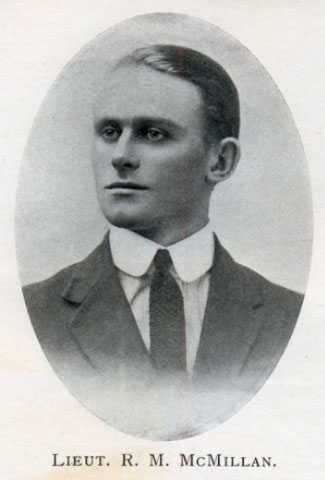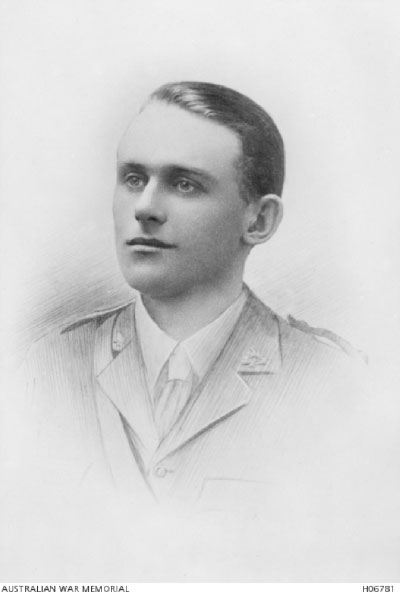War Memorial Hall c1929

Ronald Malcolm MCMILLAN

Ronald ‘Ron’ McMillan was born on 5 October 1895 in North Fitzroy, Victoria. His parents were Malcolm Reginald and Jane (née Atkinson) McMillan. He attended Scotch from 1908 to 1913. As The Scotch Collegian said, in attending Scotch College for six years, Ronald ‘entered fully into its life.’ He was involved in cricket, football, and athletics, and was outstanding at the latter. He was just beaten for the Headmaster's Cup at the College sports in 1910, and ran in the flag-race in the Scotch athletics team which won the ‘Argus and Australasian Cup’ in 1912.
Ron was in banking when he enlisted on 17 August 1914 at Melbourne, Victoria. He served in the 6th Battalion with the rank of 2nd Lieutenant. His Regimental Number was 832.
Ron died on 21 September 1917 near Ypres, Belgium. He was 21 years of age.
Service record
Ron left his job at the E.S. & A. Bank to enlist at age 18, and embarked for overseas as a Private in the 6th Battalion on 21 October 1914. He was wounded in the left forearm at Gallipoli soon after the landing. He wrote from England, where he was sent to recover: ‘I stopped one in the arm on the second day of the scuffle; it is nothing serious [it was initially diagnosed as ‘slight’], but will take some time to get well again. I was hit by an explosive bullet, and although no bones were broken, it made a nasty flesh wound and shattered some nerves, and I have temporarily lost the use of my left hand.’ He described his role and feelings at the landing: ‘I was thinking for a long time what one would feel like when first going under fire. I was surprised, I thought I would be in a blue funk for a while, but, strange to say, I hardly felt any difference between the real thing and peace manoeuvres; the only thing that makes one jump at all are the shells screaming over head, but you soon get used to these, and after a time can guess pretty well where they are going to burst, and know when it is advisable to dive for cover.
The thing that worried us most was the sniping. There were snipers all over the place; they were all disguised as bushes in the scrub, and they had their faces painted green and were covered all over with scrub; they were invisible until you got within about ten yards of them.’ He described the officers as ‘magnificent’, even a ‘trifle too brave’.
He declared himself ‘very lucky indeed’, for he came out of some ‘very tight corners’ unscathed on 25 April. ‘In one case,’ he explained, ‘about fifty of us had to charge an advanced position of the Turks. We drove them back, but only 12 of us got back alive.’ He also told how, after being evacuated from Gallipoli he was travelling on a hospital ship from Alexandria to Gibraltar, when the ship collided with another vessel and the men had to be transferred to another ship. He arrived at hospital in May 1915 but did not leave England to rejoin his unit until February 1916.
On 11 March he rejoined the 6th Battalion in Egypt. He arrived with the unit at Marseille, France on 2 April 1916. On 14 June 1916 he was convicted for the minor infringement of being ‘absent from billet without leave’, and was awarded 5 days’ Field Punishment – this probably comprised labouring duties. This did not prevent him from being promoted to Corporal on 31 July.
In December he was hospitalised with ‘I.C.T. Foot’, presumably meaning trench foot, which was rife at the time. He returned to the unit two weeks later, in January 1917. He was promoted to Sergeant on 15 March, and then 2nd Lieutenant on 23 July. Another soldier in the battalion described him at this time as not very tall, ‘rather stout’ (another said ‘well built’) and of fair hair and complexion. Another, Corporal Norris, described him as an ‘extremely lively personage…exceptionally brisk and always moved about in quick time’. Ronald was at Ypres, in Belgium, when he was killed on 21 September 1917.
His Red Cross Wounded and Missing file contains testimony from Charles Woods, of the same battalion, who said that from just a few yards away he saw Ronald ‘get killed by a shell at Glencourse Wood on the Zonnebecke front.’ Ronald was in a short trench or post with about 11 others while there was desultory shelling occurring. At about 2.30 p.m. a shell landed in the trench, killing Ronald instantly among several others. The battalion chaplain testified later that McMillan was buried on the spot as it was too dangerous to carry his body to the rear and, ‘on account of the shattered condition of the body.’ Sergeant Reuben Wheeler, in his evidence, described McMillan as ‘one of the best’.
Ronald’s service file contains a 1944 letter from his mother, Jane, informing the authorities that Ronald’s medals and commission had been destroyed in a bushfire at his brother’s house in Western Australia and asking for replacements: the answer was that it was Army policy not to issue such replacements. Ronald’s brother and fellow Old Scotch Collegian Robert also served in the First AIF. His father had the words ‘And such a death/ is immortality’ engraved on Ronald’s cross.
Ronald McMillan is buried in the Hooge Crater Cemetery (Plot II, Row C, Grave No. II), Zillebeke, Belgium.
Photographs and Documents:

Undated portrait of Ronald McMillan as a 2nd Lieutenant
Sources:
- Australian War Memorial – Roll of Honour and Red Cross Wounded and Missing file
- Commonwealth War Graves Commission Website
- Mishura Scotch Database
- National Archives of Australia – B2455, MCMILLAN RM
- Scotch Collegian 1915 and 1917
- The AIF Project - https://www.aif.adfa.edu.au/showPerson?pid=203589


